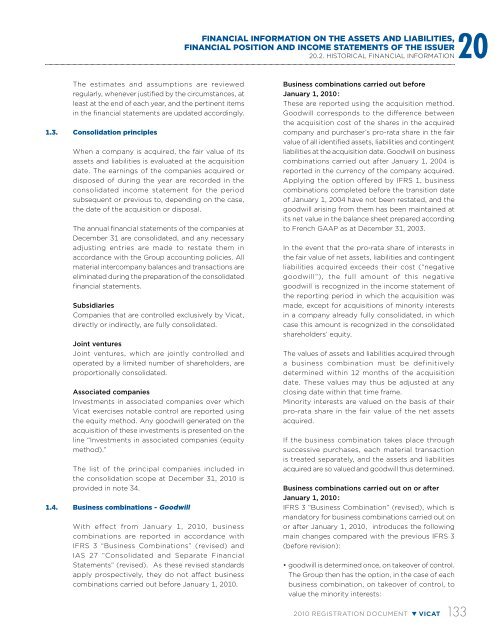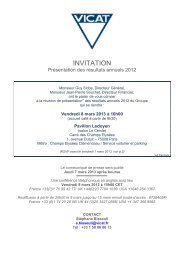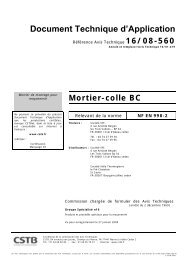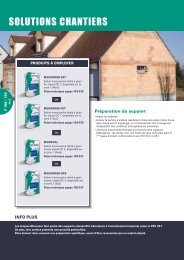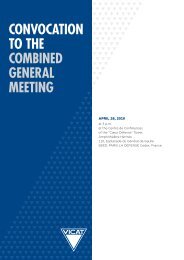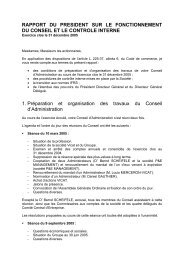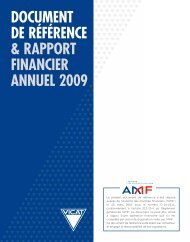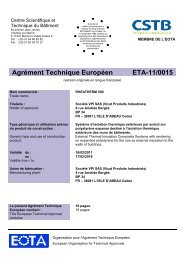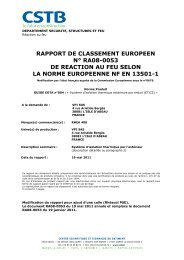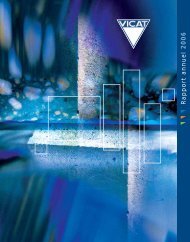6 - Vicat
6 - Vicat
6 - Vicat
Create successful ePaper yourself
Turn your PDF publications into a flip-book with our unique Google optimized e-Paper software.
Financial information on the assets and liabilities,financial position and income statements of the issuer20.2. Historical financial information20The estimates and assumptions are reviewedregularly, whenever justified by the circumstances, atleast at the end of each year, and the pertinent itemsin the financial statements are updated accordingly.1.3. Consolidation principlesWhen a company is acquired, the fair value of itsassets and liabilities is evaluated at the acquisitiondate. The earnings of the companies acquired ordisposed of during the year are recorded in theconsolidated income statement for the periodsubsequent or previous to, depending on the case,the date of the acquisition or disposal.The annual financial statements of the companies atDecember 31 are consolidated, and any necessaryadjusting entries are made to restate them inaccordance with the Group accounting policies. Allmaterial intercompany balances and transactions areeliminated during the preparation of the consolidatedfinancial statements.SubsidiariesCompanies that are controlled exclusively by <strong>Vicat</strong>,directly or indirectly, are fully consolidated.Joint venturesJoint ventures, which are jointly controlled andoperated by a limited number of shareholders, areproportionally consolidated.Associated companiesInvestments in associated companies over which<strong>Vicat</strong> exercises notable control are reported usingthe equity method. Any goodwill generated on theacquisition of these investments is presented on theline “Investments in associated companies (equitymethod).”The list of the principal companies included inthe consolidation scope at December 31, 2010 isprovided in note 34.1.4. Business combinations - GoodwillWith effect from January 1, 2010, businesscombinations are reported in accordance withIFRS 3 “Business Combinations” (revised) andIAS 27 “Consolidated and Separate FinancialStatements” (revised). As these revised standardsapply prospectively, they do not affect businesscombinations carried out before January 1, 2010.Business combinations carried out beforeJanuary 1, 2010 :These are reported using the acquisition method.Goodwill corresponds to the difference betweenthe acquisition cost of the shares in the acquiredcompany and purchaser’s pro-rata share in the fairvalue of all identified assets, liabilities and contingentliabilities at the acquisition date. Goodwill on businesscombinations carried out after January 1, 2004 isreported in the currency of the company acquired.Applying the option offered by IFRS 1, businesscombinations completed before the transition dateof January 1, 2004 have not been restated, and thegoodwill arising from them has been maintained atits net value in the balance sheet prepared accordingto French GAAP as at December 31, 2003.In the event that the pro-rata share of interests inthe fair value of net assets, liabilities and contingentliabilities acquired exceeds their cost (“negativegoodwill”), the full amount of this negativegoodwill is recognized in the income statement ofthe reporting period in which the acquisition wasmade, except for acquisitions of minority interestsin a company already fully consolidated, in whichcase this amount is recognized in the consolidatedshareholders’ equity.The values of assets and liabilities acquired througha business combination must be definitivelydetermined within 12 months of the acquisitiondate. These values may thus be adjusted at anyclosing date within that time frame.Minority interests are valued on the basis of theirpro-rata share in the fair value of the net assetsacquired.If the business combination takes place throughsuccessive purchases, each material transactionis treated separately, and the assets and liabilitiesacquired are so valued and goodwill thus determined.Business combinations carried out on or afterJanuary 1, 2010 :IFRS 3 “Business Combination” (revised), which ismandatory for business combinations carried out onor after January 1, 2010, introduces the followingmain changes compared with the previous IFRS 3(before revision):• goodwill is determined once, on takeover of control.The Group then has the option, in the case of eachbusiness combination, on takeover of control, tovalue the minority interests:2010 registration document VICAT 133


